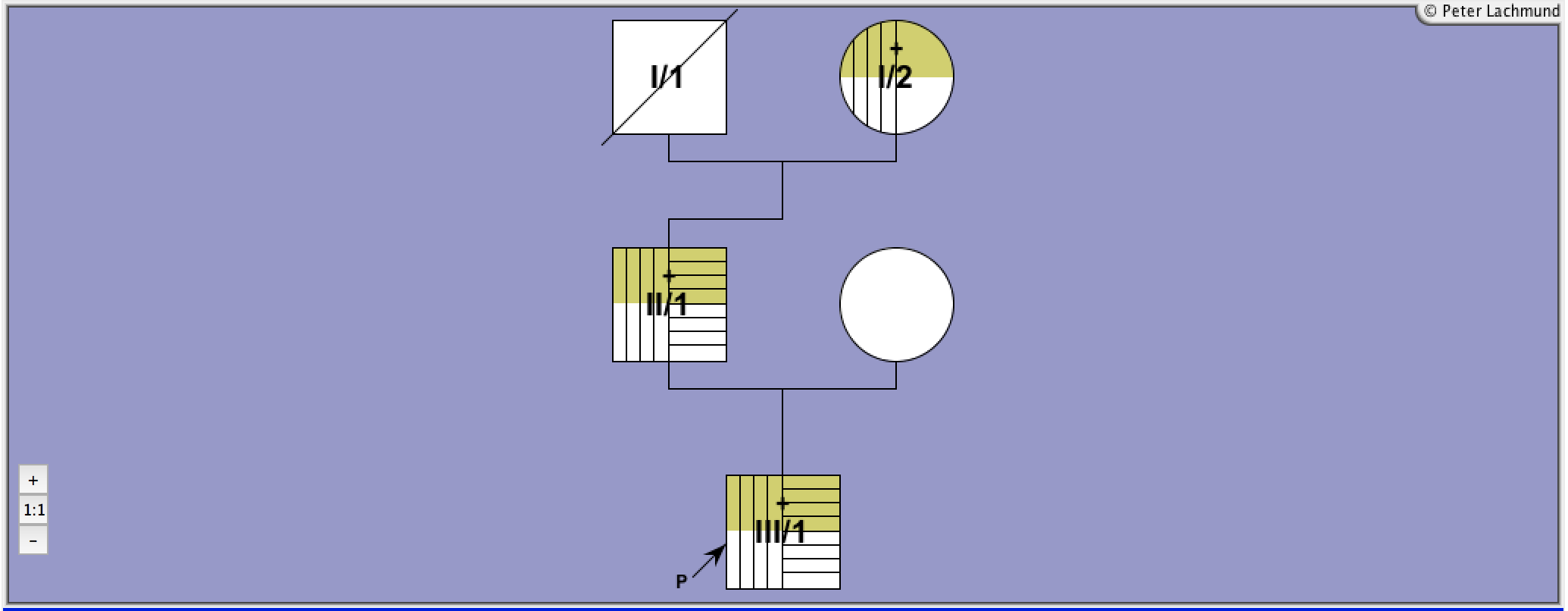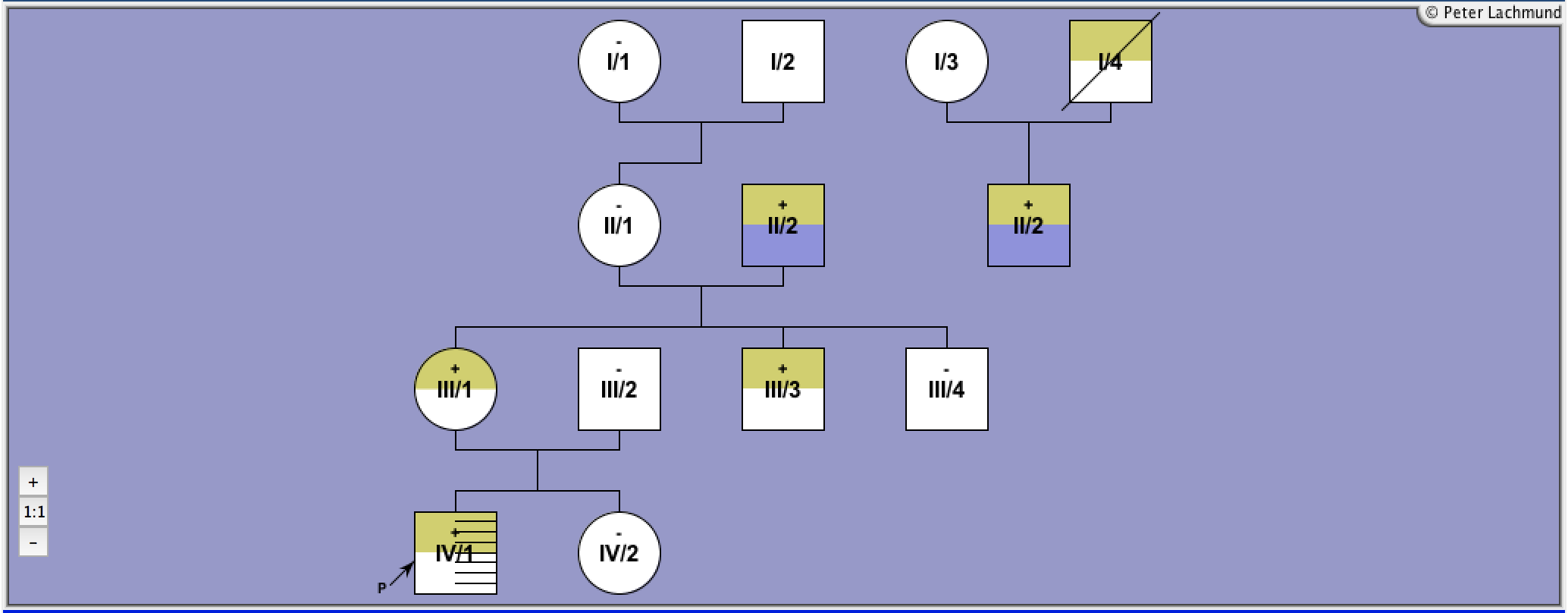Details Of Published TSH Receptor Mutation
Gly 431 Ser
c.1292G>AConstitutively Activating TSH Receptor Mutation
Type
gain
Manifestation
family
Exon
10
Legend:

Male

Female

Unknown

Deceased
+
Mutation
-
No Mutation

Hyperthyroidism
(Heterozygous)
(Heterozygous)

Goiter

Relapse
P
Index Patient
Molecular Characteristics:
G431S creates novel DdeI restriction site
hereditary occurrence in two non-related families
Family 1 - Pedigree 1: Biebermann et al.
Family 2 - Pedigree 2: Elagdi et al.
Note:Blue marked individuals are indentical (P2/II/2)
hereditary occurrence in two non-related families
Family 1 - Pedigree 1: Biebermann et al.
Family 2 - Pedigree 2: Elagdi et al.
Note:Blue marked individuals are indentical (P2/II/2)
Clinical Features:
Family 1 - Pedigree 1 (Biebermann et al):
diagnosis:
P1/III/1: 3yr (index patient)
P1/II/1: 4yr
P1/I/2: adolescence
P1/III/1: prominent eyes but no exophthalmus (MRI)
Family 2 - Pedigree 2 (Elgadi et al.):
diagnosis:
P2/IV/1: 5yr (index patient)
P2/III/1: 17yr
P2/III/2: 13yr
P2/II/1: no age of diagnosis reported
P2/IV/1: excessive sweating, morning stiffness, pain in lower limbs
P2/II/1: supraventricular tachycardia
P2/I/2: hyperthyroid
* based on 2 hot nodules investigated by Paloz-Paz et al. 2008
and 4 activating familial germline mutations investigated by Biebermann et al. 2001,
Elgadi et al. 2005, Larsen et al 2014 and Winkler et al 2010
diagnosis:
P1/III/1: 3yr (index patient)
P1/II/1: 4yr
P1/I/2: adolescence
P1/III/1: prominent eyes but no exophthalmus (MRI)
Family 2 - Pedigree 2 (Elgadi et al.):
diagnosis:
P2/IV/1: 5yr (index patient)
P2/III/1: 17yr
P2/III/2: 13yr
P2/II/1: no age of diagnosis reported
P2/IV/1: excessive sweating, morning stiffness, pain in lower limbs
P2/II/1: supraventricular tachycardia
P2/I/2: hyperthyroid
* based on 2 hot nodules investigated by Paloz-Paz et al. 2008
and 4 activating familial germline mutations investigated by Biebermann et al. 2001,
Elgadi et al. 2005, Larsen et al 2014 and Winkler et al 2010
Treatment:
Family 1 - Pedigree 1 (Biebermann et al.):
P1/III/1: antithyroid drugs ineffective, total TE at 7.75yr, clinically euthyroid with L-T4
P1/II/1: antithyroid drugs ineffective, subtotal TE at 7.5yr, euthyroid since
P1/I/1: subtotal TE at 15yr, now unilateral goiter, clinically euthyroid
Family 2 - Pedigree 2 (Elgadi et al.):
P2/IV/1: antithyroid drugs and L-T4, relapse after discontinuation, subtotal TE at 8.4yr, euthyroid with L-T4
P2/III/1, P2/III/2, P2/II/1: antithyroid drugs and L-T4
P2/III/1: TE at 18yr
P2/III/2: TE at 15yr
P2/II/1: TE
P1/III/1: antithyroid drugs ineffective, total TE at 7.75yr, clinically euthyroid with L-T4
P1/II/1: antithyroid drugs ineffective, subtotal TE at 7.5yr, euthyroid since
P1/I/1: subtotal TE at 15yr, now unilateral goiter, clinically euthyroid
Family 2 - Pedigree 2 (Elgadi et al.):
P2/IV/1: antithyroid drugs and L-T4, relapse after discontinuation, subtotal TE at 8.4yr, euthyroid with L-T4
P2/III/1, P2/III/2, P2/II/1: antithyroid drugs and L-T4
P2/III/1: TE at 18yr
P2/III/2: TE at 15yr
P2/II/1: TE
Functional Characteristics:
cAMP
(basal)
(basal)
cAMP
(TSH)
(TSH)
IP
(basal)
(basal)
IP
(TSH)
(TSH)
TSH-Binding
Cell Surface Expression
Prevalence
LRA
Ref
2.5-6.3
0.6-1.3
0.7-1.4
0.8-1.1
~
0.9
4
4.9+/-0.5;5.8+/-0.6
1,3,4
Legend:
cAMP (basal): basal in vitro cAMP production of mutant over wild-type TSHR
cAMP (TSH): maximal in vitro cAMP production of mutant over wild-type TSHR
IP (basal): basal in vitro IP production of mutant over wild-type TSHR
IP (TSH): maximal in vitro IP production of mutant over wild-type TSHR
TSH-binding: maximal TSH-binding compared to the wild-type TSHR
Cell surface expression: cell surface expression of mutant compared to WT-TSHR
LRA: linear regression analysis (LRA) of constitutive activity as a function of TSHR expression determined by 125I-bTSH binding or FACS analysis compared to the wild-type TSHR
Prevalence: Prevalence of (somatic and germline) activating mutations*
Ref: Reference for functional characterization
Child: Found in children.
Reference 1:
Biebermann et al.
J. Clin. Endocrinol. Metab. 86: 4429-4444
The first activating TSH receptor mutation in transmembrane domain 1 identified in a family with nonautoimmune hyperthyroidism
2001
Reference 2:
Elgadi et al.
Acta Paediatr. 94: 1145-8
Autosomal-dominant non-autoimmune hyperthyroidism presenting with neuromuscular symptoms.
2005
Reference 3:
Mueller et al.
Thyroid. 19(7):765-73
Cases of borderline in vitro constitutive thyrotropin receptor activity: how to decide whether a thyrotropin receptor mutation is constitutively active or not?
2009
Reference 4:
Jäschke et al.
Cell Mol Life Sci 65:4028-4038
Preferences of transmembrane helices for cooperative amplification of G(alpha)s and G (alpha)q signaling of the thyrotropin receptor.
2008
Reference 5:
Larsen et al.
International journal of pediatric endocrinology
A new family with an activating mutation (G431S) in the TSH receptor gene: a phenotype discussion and review of the literature
2014



